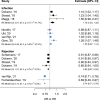Torque teno virus load as marker of rejection and infection in solid organ transplantation - A systematic review and meta-analysis
- PMID: 36056751
- PMCID: PMC10078304
- DOI: 10.1002/rmv.2393
Torque teno virus load as marker of rejection and infection in solid organ transplantation - A systematic review and meta-analysis
Abstract
Balancing immunosuppression to prevent rejection in solid organ transplant (SOT) recipients remains challenging. Torque teno virus (TTV), a commensal non-pathogenic virus, has been proposed as marker of functional immunity: higher loads correspond to over-immunosuppression, and lower loads to under-immunosuppression. This review offers an overview of the current evidence of the association between TTV-load and infection and rejection after SOT. A systematic literature search strategy, deposited in the PROSPERO registry, resulted in 548 records. After screening, 23 original and peer-reviewed articles were assessed investigating the association between TTV-load, infection and/or rejection in SOT. The Quality in Prognostic Studies (QUIPS)-tool was used to assess the risk of bias. Meta-analysis with random-effects was performed on results with similar outcomes and exposure measures. Most of the included studies involved retrospective cohorts in which the TTV-load was measured longitudinally, within the first 2 years post-transplantation. Infection outcomes differed between studies and included viral, bacterial, parasitic and fungal infections. Rejection was defined by biopsy confirmation or initiation of rejection treatment. Twelve out of 16 studies reported an association between high TTV-load and infections, whereas 13 out of 15 reported an association between low TTV-load and rejection. Meta-analysis showed an increased risk of infection (OR: 1.16, 95% CI: 1.03-1.32; HR: 1.05, 95% CI: 0.97-1.14) and a decreased risk of rejection (OR: 0.90, 95% CI: 0.87-0.94; HR: 0.74, 95% CI: 0.71-0.76) per 1 log TTV-load increase. The qualitative assessment showed varying risks of bias in the included studies. This systematic review and meta-analysis indicates that blood TTV-load measured within the first 2 years after SOT is associated with the risk of infection or allograft rejection, although substantial risk of bias in the studies included warrant cautious interpretation. The results in this review provide a rationale for larger, prospective, studies into TTV as marker of infection and rejection after SOT.
Keywords: TTV; biomarker; immunocompromised; solid organ transplantation.
© 2022 The Authors. Reviews in Medical Virology published by John Wiley & Sons Ltd.
Conflict of interest statement
AL van Rijn, MCW Feltkamp and JI Rotmans are consortium partners of the EU‐funded TTV Guide Tx trial (
Figures




References
-
- Redondo N, Navarro D, Aguado JM, Fernandez‐Ruiz M. Viruses, friends, and foes: the case of Torque Teno Virus and the net state of immunosuppression. Transpl Infect Dis. 2021:e13778 - PubMed
Publication types
MeSH terms
Substances
LinkOut - more resources
Full Text Sources
Medical

